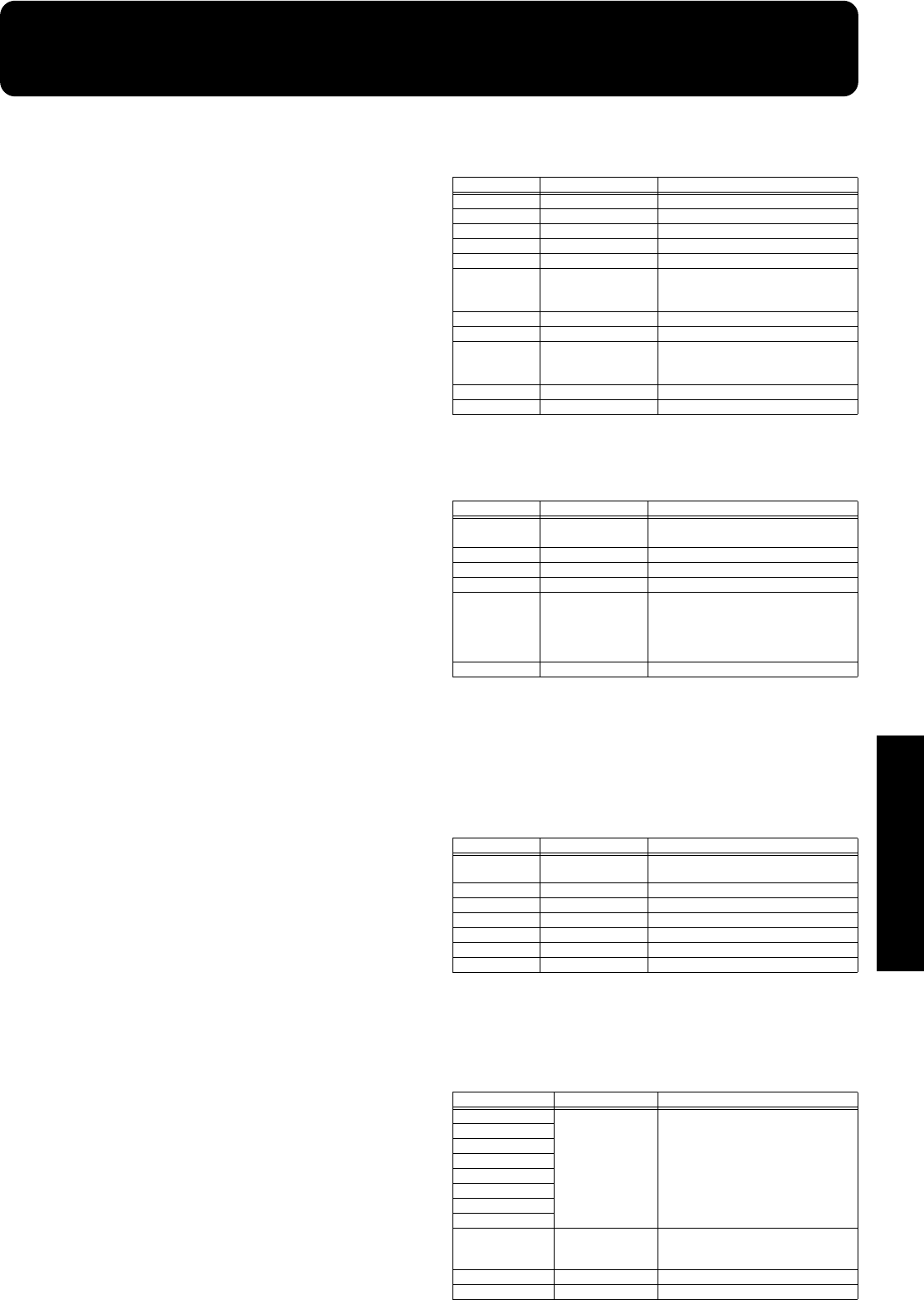
91
Appendices
Effects/Parameter List
The multi-effects feature 40 different kinds of effects. Some of the
effects consist of two different effects connected in series or in
parallel.
Parameters marked with a sharp “#” can be controlled using the
MFX [CONTROL] knob on the Synth section (Two setting items will
change simultaneously for “#1” and “#2”).
1: STEREO EQ (p. 91)
2: OVERDRIVE (p. 91)
3: DISTORTION (p. 91)
4: PHASER (p. 91)
5: SPECTRUM (p. 91)
6: ENHANCER (p. 92)
7: AUTO WAH (p. 92)
8: ROTARY (p. 92)
9: COMPRESSOR (p. 92)
10: LIMITER (p. 92)
11: HEXA-CHORUS (p. 92)
12: TREMOLO CHO (p. 92)
13: SPACE-D (p. 93)
14: STEREO CHORUS (p. 93)
15: ST.FLANGER (p. 93)
16: STEP FLANGER (p. 93)
17: STEREO DELAY (p. 93)
18: MOD DELAY (p. 94)
19: TRI TAP DLY (p. 94)
20: QUAD TAP DLY (p. 94)
21: TIME CTRL DLY (p. 95)
22: 2V PCH SHIFT (p. 95)
23: FBK PCH SHIFT (p. 95)
24: REVERB (p. 95)
25: GATED REVERB (p. 96)
26: OD -> CHORUS (p. 96)
27: OD -> FLANGER (p. 96)
28: OD -> DELAY (p. 96)
29: DIST -> CHORUS (p. 96)
30: DIST -> FLANGER (p. 97)
31: DIST -> DELAY (p. 97)
32: ENHAN -> CHORUS (p. 97)
33: ENHAN -> FLANGER (p. 97)
34: ENHANCR -> DELAY (p. 97)
35: CHORUS -> DELAY (p. 97)
36: FLANGER -> DELAY (p. 98)
37: CHORUS -> FLANGR (p. 98)
38: CHORUS/DELAY (p. 98)
39: FLANGER/DELAY (p. 98)
40: CHORUS/FLANGER (p. 98)
1: STEREO EQ (Stereo Equalizer)
This is a four-band stereo equalizer (low, mid x 2, high).
2: OVERDRIVE
Creates a soft distortion similar to that produced by vacuum tube
amplifiers.
3: DISTORTION
Produces a more intense distortion than Overdrive. The parameters
are the same as for “2: OVERDRIVE.”
4: PHASER
Adds a phase-shifted sound to the original sound, producing a
twisting modulation that creates spaciousness and depth.
5: SPECTRUM
This is a type of filter which modifies the timbre by boosting or
cutting the level at specific frequencies. It is similar to an equalizer,
but has 8 frequency points fixed at locations most suitable for adding
character to the sound.
Parameter Value Explanation
Low Freq 200, 400 Hz Frequency of the low range
Low Gain -15–+15 dB Gain of the low range
High Freq 2000, 4000, 8000 Hz Frequency of the high range
High Gain -15–+15 dB Gain of the high range
Mid1 Freq 200–8000 Hz Frequency of the middle range 1
Mid1 Q 0.5, 1.0, 2.0, 4.0, 8.0 Width of the middle range 1
Set a higher value for Q to nar-
row the range to be affected.
Mid1 Gain -15–+15 dB Gain of the middle range 1
Mid2 Freq 200–8000 Hz Frequency of the middle range 2
Mid2 Q 0.5, 1.0, 2.0, 4.0, 8.0 Width of the middle range 2
Set a higher value for Q to nar-
row the range to be affected.
Mid2 Gain -15–+15 dB Gain of the middle range 2
Level # 0–127 Output Level
Parameter Value Explanation
Drive # 0–127 Degree of distortion
Also changes the volume.
Level 0–127 Output Level
Low Gain -15–+15 dB Gain of the low range
High Gain -15–+15 dB Gain of the high range
Amp Type SMALL,
BUILT-IN,
2-STACK,
3-STACK
Type of guitar amp
SMALL: small amp
BUILT-IN: single-unit type amp
2-STACK: large double stack amp
3-STACK: large triple stack amp
Pan # L64–63R Stereo location of the output sound
Parameter Value Explanation
Manual # 100–8000 Hz Adjusts the basic frequency from
which the sound will be modulated.
Rate # 0.05–10.00 Hz Frequency of modulation
Depth 0–127 Depth of modulation
Resonance 0–127 Amount of feedback
Mix 0–127 Level of the phase-shifted sound
Pan L64–63R Stereo location of the output sound
Level 0–127 Output Level
Parameter Value Explanation
Band1 (250Hz) -15–+15 dB Gain of each frequency band
Band2 (500Hz)
Band3 (1000Hz)
Band4 (1250Hz)
Band5 (2000Hz)
Band6 (3150Hz)
Band7 (4000Hz)
Band8 (8000Hz)
Q 0.5, 1.0, 2.0, 4.0,
8.0
Simultaneously adjusts the width
of the adjusted ranges for all the
frequency bands.
Pan # L64–63R Stereo location of the output sound
Level # 0–127 Output Level


















